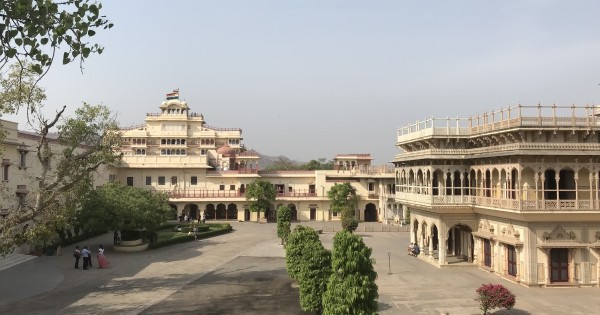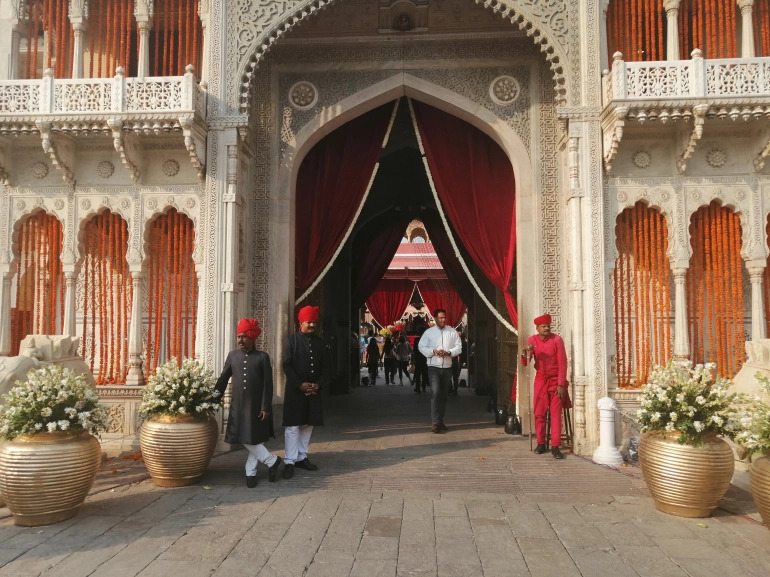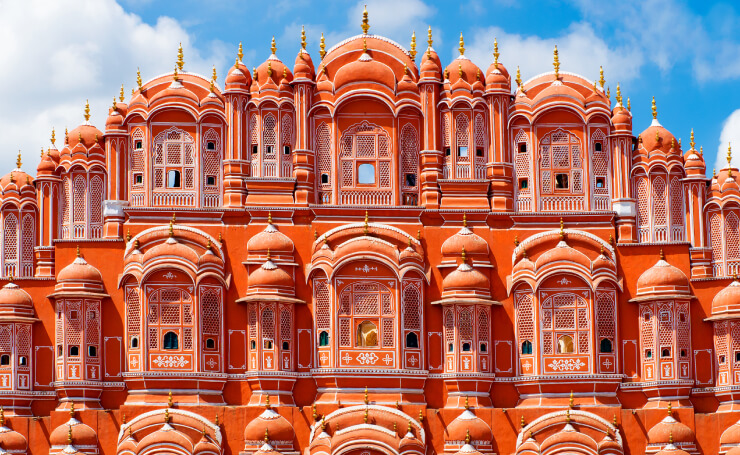


Jaipur is an intriguing blend of historic forts, regal palaces, bustling bazaars, and contemporary, gleaming shopping malls and busy business areas.
Jaipur, an incredible city founded in 1727 by Maharaja Sawai Jai Singh, was skillfully planned out on the ethos of old architectural principles. Encircled on three sides by the mighty Aravalli Hills, it represents the glory of Indian history. The medieval old city, which is at the centre of Jaipur, is encircled by enormous defence walls and is accessible by eight imposing gates. The old city is divided into tidy rectangles by broad avenues lined with camel carts, cycle rickshaws, and wandering cows, each of which specializes in a particular variety of Rajasthan's renowned handicrafts. Traditional bazaars are stuffed with vibrant textiles, exquisite pottery, and the renowned jewellery of the area.
The City Palace, the maharajas' extravagantly decorated house, is located in the old city, which is spectacular and striking. A booming city, Jaipur has long outgrown its original defensive walls, and on the outside of the city, with its new extensions, is a spectacular series of forts, palaces, cenotaphs, and other vestiges of the maharajas. The stately Amber Fort, one of Rajasthan's most striking structures, guards the city from its own perch atop a rough hilltop overlooking Jaipur's outskirts.

1. Airway: Jaipur International Airport is connected widely with all the major domestic aircrafts and locations. Additionally, there are international flights from Jaipur to Singapore, Dubai, Muscat, and Bangkok, making it more accessible for international and domestic tourists alike
2. Roadway: Road travel to Jaipur is a practical option if you are traveling from neighboring states or capital New Delhi. Regular AC and Deluxe bus service departs from all the major cities.
3. Railway: All significant cities, including Delhi, Agra, Mumbai, Chennai, Kolkata, Bangalore, etc., are connected to Jaipur via train. You make this experience royal & exuberant by traveling on ‘Palace on Wheels’.
Summer (May – September):Min 25°C/77°F Max 45°C/113°F
Winter (October – April): Min 5°C/41°F Max 25°C/77°F
The best time to visit Jaipuris generally considered to be in the winter. The princely city enjoys a slightly warmer climate. You’ll find the days are pleasant and sunny, however it tends to get chilly at night during this time of year. It’s like experiencing the best of both the worlds
There are many amazing and thrilling fairs and festivals that take place in different locations during the winter in Jaipur to give you the best out of your tour.
2-3 days are sufficient for visiting the popular sights in Jaipur, but if you wish to see the hidden gems and enjoy Jaipur to its fullest plan for a 5 day trip.

1. Amber Palace
It is located approximately 11 kilometers away from Jaipur. The palace, which is situated in rocky hills and is now a UNESCO World Heritage Site, is a stunning fusion of Hindu and Mughal architecture. In 1592, Raja Man Singh I started work on the palace. The harsh outside and the cozy inside contrast in the most unconventional way a beautiful contrast of the palace. Visitors are captivated by the splendor of the palace, which makes use of sculptures, precious stones, and mirrors. The palace is made completely of red sandstone and white marble. One can witness the view of soothing Maota Lake in front adding to the palace's breathtaking beauty. The palace has a fascinating heritage and is around seven centuries old.
2. City Palace
The City Palace Complex, which is the heart inside the walled city, was designed and constructed by Maharaja Sawai Jai Singh II, the founder of Jaipur. The last ruling royal family still resides at the palace in a private area, making it more realistic and connected to the royal tour. This structure is a stunning blend of artistic and majestic architecture. The majority of the planning & constructions were created by Maharaja Sawai Jai Singh II, but other kings also added to them. It includes a noteworthy collection of exceptionally well-preserved Rajput weapons, some dating back to the fifteenth century. The palace is decorated with well-maintained ceiling murals in addition to the weapons.
3. Hawa Mahal
The poet king Sawai Pratap Singh constructed the Hawa Mahal, also known as the Palace of Winds, in 1799 as a summer residence for himself and his family. It served as a sightseeing point where the ladies of the Royal and noble households may witness daily life and festivities there without being seen themselves. The outside of this unique five-story building, which is a combination of elements of Rajput and Islamic architecture and is beautified with small latticed windows known as jharokhas. This visual imagery is meant to evoke the crown of Lord Krishna hence acting as a gem in Jaipur's must visit places. The palace's intricate windows act as a sort of air conditioner, and is astonishingly cooler even in the hot summer weather. The Hawa Mahal, a famous landmark in Jaipur made of pink sandstone, can be seen from the exterior and across the street in all its splendor.
Although, most popular historical places are in and around the walled-city of Jaipur, you’ll find limited options except some two or three tier guest houses and hotels to stay.
Along Sansarchandra and Station roads are all the hotels that are most accessible to the Old City. These major thoroughfares are close to the inner-city attractions, the meager metro services, and the train and bus facilities. Bani Park, a suburban community with respectable stores, broad avenues, and likable affordable options, is also convenient. There are a number of upscale hotels in the area surrounding Rambagh's expansive parks that offer the kind of pubs and nightclubs that are uncommon elsewhere.
~ Best Boutique Hotels in Jaipur Bissau Palace, Dera Mandawa, and Pearl Palace Heritage
~ Heritage Hotels are among the best luxury hotels in Jaipur, along with Raj Palace, Alsisar Haveli, and Umaid Mahal.
~ Atithi Guest House, Arya Niwas, and Madhuban are among the best inexpensive hotels in Jaipur.>